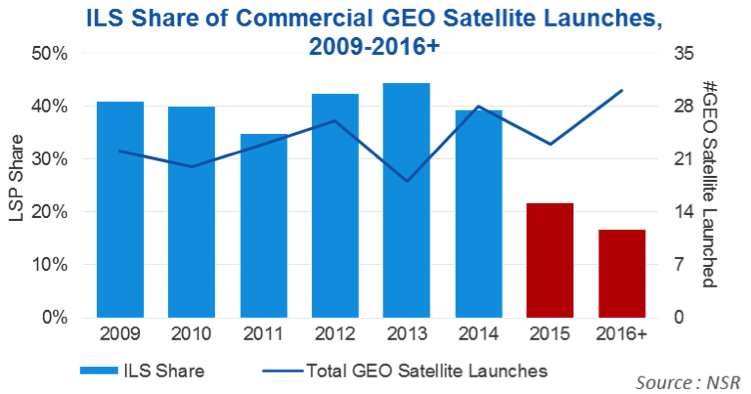|
Easy Pickings in GEO Launch Services
Jun 11th, 2014 by
Stéphane Gounari, NSR
On May 15, a Proton Breeze-M failed while launching Ekspress-AM
4R, adding to the string of failures and malfunctions affecting
the rocket for several years (six since 2010). Combined with
delays in Arianespace’s launch rhythm and the situation of the
other launch players, the latest failure creates a unique
situation in launch services: while there are too many players
for the market, there is currently a scarcity of reliable and
affordable GEO Launch Services.
ILS’ backlog was already considerably down before the last
failure, and the latter will make ILS’ potential return to
normal more difficult, providing a welcome window of
opportunities to other providers.

SpaceX saw its backlog of GEO launches grow in the last
years, but it is not yet operating at a fast pace, resulting in
repeated delays and a worrying growing backlog to GEO and other
orbits. Moreover, the Falcon 9 does not have the mass capability
to launch satellites that should have used Proton.
After several years focusing on the U.S. governmental and
military market, Lockheed Martin Commercial Launch Services is
now trying to grow back its share of the commercial market. In
late 2013, it won a commercial contract stating it was able to
drop its costs by 20%. It seems the price is not yet at market
levels as this win was not followed by any other since then, but
it aims at securing one commercial launch per year.
Mitsubishi Heavy Industries (MHI), like Lockheed, is turning
its attention back to the commercial market. Restrained by high
costs and a launch site not ideally located, it is currently
working on an improvement and cost reduction program. MHI
recently received an order from Sky Perfect JSAT, based in Japan
for a launch in 2016. This tends to indicate that MHI’s efforts
are paying off but another order, not from a Japan-based
company, would be the best confirmation. In any case, MHI does
not have a huge launch capability and aims at 3 commercial
missions per year.
Finally, Sea Launch had some difficulties in growing its
market share since emerging from bankruptcy. On May 26, Sea
Launch succeeded in delivering a GTO satellite into orbit. It is
a long awaited success for the firm, and a very well-timed one,
contributing to reinforce Sea Launch’s image as a reliable
provider.
As a direct consequence of this situation, Arianespace’s
backlog of GEO launches has been growing. However, its launch
rate is already at its maximum and the rocket is actually
regularly delayed due to issues with satellite deliveries. This
already caused Arianespace’s low activity level in 2013, and it
is not improving as illustrated by the recent delay of
Measat-3b’s launch from May to September 2014.
Bottom Line
The current situation in the Launch Services market
is a perfect storm that creates scarcity in a market that should
normally be in a position of oversupply. Sea Launch
seems to be in a very good position to take advantage of this
situation, but one should not forget MHI and Lockheed Martin
Commercial Services (although they are both hampered by high
costs). A shortage of reliable launch services places higher
value on their reliability, partially compensating their lack of
competitiveness. If they play their cards smartly, fulfilling
their sales target (3 per year for MHI and 1 for Lockheed)
should prove easy. While Sea Launch does not feature a perfect
reliability score, it is nonetheless at a very decent level and
its availability and price should prove a powerful complement.
Thus, while too many players vie for a piece of the pie, easy
pickings in GEO launch contracts are there for the players with
the right cards.
|